Celebrating the beauty and diversity of British gardens, the Garden of the Year award recognises where traditional horticultural design has been paired with modern regeneration.
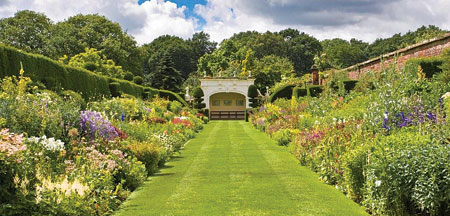 |
| Arley Hall and Gardens, Cheshire – 1987 Winner |
For any gardens enthusiast visiting Britain, there is no better group around which to plan an itinerary than the distinguished winners of the Garden of the Year Award. Taken together, they represent the finest possible cross-section of the English country garden. Of the 26 winners, some are incredibly grand, others far smaller and intimate, but they all pay homage to the tradition of the English country house and garden that is one of the most abiding attractions to visitors.
The competition’s organiser, the Historic Houses Association (HHA), was founded in 1973 to support and provide a forum for the owners of Britain’s stately homes. This was a challenging proposition in the anti-elitist late-20th century, but over the years it has got across the message that these places are beacons of heritage rather than bastions of privilege.
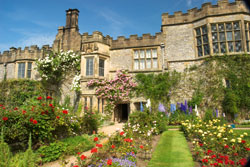 |
| Haddon Hall, Derbyshire – 1993 Winner |
It was a stroke of genius when, in 1983, the HHA announced that with generous sponsorship from the auctioneers, Christie’s, they were going to launch a Garden of the Year competition for their members. The rules were simple; HHA members and friends (currently around 30,000) would vote for gardens as they visited, and the garden with the most votes would win. It was decided that no garden could win more than once and that where the votes have been particularly close, geographical spread has been favoured. Each year’s victory is celebrated with a ceremony in the garden which Charles Cator, Deputy Chairman of Christie’s, particularly enjoys because, “They are all so different and yet marvellously English.”
Peter Sinclair, Assistant Director of the HHA, joined the association only a few years after the competition started and recalls, “The idea was to come up with an award that would raise the HHA’s profile. By choosing the gardens rather than the houses, which might have been more predictable, the HHA immediately made it more inclusive, focusing on the visitor experience and highlighting the hands-on commitment of the owners.”
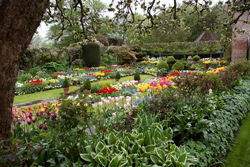 |
| Chenies Manor – latest winner |
Chenies Manor in Buckinghamshire, which was announced as the 2009 winner in March this year, is a good example. Anthony and Elizabeth MacLeod Matthews bought Chenies in the 1950s and have devoted themselves to restoring and improving it, and opening it up to visitors. “The gardens were overgrown with Victorian shrubberies and laurel hedging when we first arrived,” Elizabeth MacLeod Matthews recalls. “We were fascinated to discover that there had been a formal garden here centuries ago and that both Henry VIII and Elizabeth I were visitors. The romantic and illustrious history both inspired and guided us and we consciously developed a garden which evokes the Tudor and Stuart heyday.” Now, the warm brick terraces and sunken garden are adorned with topiary and two flowering spectaculars; first tulips and then, in an intense procedure during the first two weeks of June, the tulips are replaced with thousands of plants, raised in the greenhouses, to take the garden through summer and autumn.
Elizabeth MacLeod Matthews feels rather overawed to be joining the ranks of winners. “I look at them and feel to be among them is wonderful,” she says. And she only has to look at last year’s winner, Blenheim Palace, to see the other end of the country house and garden spectrum from Chenies. Yet here, too, in one of the grandest gardens in the country, there are the same fundamentals of the garden being crucial to the overall appeal to visitors. There is also similar enthusiasm from the owning family, exemplified in Blenheim Palace by the restoration work overseen by the present Duke of Marlborough of his father’s Private Garden. To celebrate the tercentenary of the Battle of Blenheim, it was re-opened in 2004 as the Secret Garden. The Duke showed his pride in Blenheim past and present explaining, “This award recognises the vision and enthusiasm of my illustrious ancestors, as well as celebrating the excellent work undertaken here today by the gardens team.”
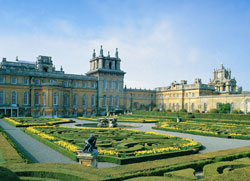 |
| Blenheim Palace, Oxfordshire – 2008 Winner |
For many garden visitors, the personal contact is as enjoyable as the horticultural and in many of these gardens you are likely to come across one of the owners toiling away in a border or greeting you as you arrive. The HHA champions continuity for country houses and the sense of establishment is one of the most powerful characteristics of all these gardens. Of the 26 winners, only two have been sold during the life of the competition. In all of the others, continuity is remarkable and many have now passed to the next generation since they won the award.
This is the case at the very first winner, elegant Heale House in Wiltshire whose garden overlooks the River Avon. In 1984, the award was clear recognition of the work done by Lady Anne Rasch to restore and develop the garden begun by her Edwardian ancestors. Today, her son and daughter-in-law, Guy and Frances Rasch, continue the work. Frances is conscious of the balance between change and continuity, explaining, “Everybody gardens in a different way and, in lots of detail, it’s a different garden from 26 years ago. But what visitors will always see is the timeless composition of the house, its setting and the garden framework laid out by Harold Peto. Everyone else’s work, my mother-in-law’s and ours, is layered on top.”
Similar family stories lie behind the successes of many other gardens. Houghton Hall in Norfolk won in 2007 because of the spectacular restoration of the walled garden carried out by Lord Cholmondeley in memory of his grandmother. Houghton is one of England’s most renowned houses, but the garden is far less well known. Houghton’s head gardener, Mhari Blanchfield, has worked there for ten years and has found the renewal of the great walled garden, covering 5.25 acres, incredibly exciting. “It’s hard to imagine that some 20 years ago, the whole area within the walls was grassed over,” she says. “An estate tractor came in and ploughed it all up and by the time I arrived, the new planting was becoming established. We all find it such a lovely place to work because of the variety, from traditional vegetables and herbaceous borders to a more unusual north border and lots of different fruit varieties. But for me the best thing is the mixture of traditional things with more contemporary and modern features, such as the sculptures and new water feature called Water Flame. I like the thought that within the grand scheme of things at Houghton, the garden is very young and yet it is already showing signs of maturity.”
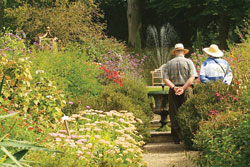 |
| Newby Hall, Yorkshire – 1986 Winner |
Building on the foundations laid by distinguished gardening relatives has also been the inspiration at Newby in Yorkshire, Levens in Cumbria and Kiftsgate in Gloucestershire. Personally, the list of gardens contains many of my all-time favourites: Arley in Cheshire with the oldest herbaceous borders in England of which garden designer Gertrude Jekyll wrote over 100 years ago, “It would be hard to find borders handsomer or in any way better done than those at Arley”; Haddon in Derbyshire, where the romantic gabled house embraces terraces strewn with old-fashioned roses; and Cottesbrooke in Northamptonshire, where a sensational inter-war garden has been built upon by two subsequent generations.
Richard Roundell, the Vice Chairman of Christie’s, who has been involved with the competition for many years, points to the fact that not every county might have a winner, but for the travelling visitor no region of England is without at least one – except perhaps the far south-west. As he comments, “Given their mild climate and reputation for gardens it is most surprising that there has not been a winner from either Devon or Cornwall.”
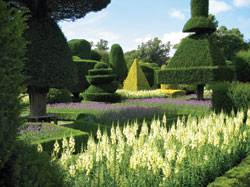 |
| Levens Hall, Cumbria – 1994 Winner |
No doubt the men and women of the West Country will make amends. In the meantime, visitors can enjoy a competition that sheds well-deserved limelight on a selection of gardens and sees their popularity blossom. Quite rightly, this is what makes Edward Harley, the current President of the HHA, most proud. “The success of this award is driven by the huge enjoyment which people gain from visiting gardens,” he says. “Over 26 years, the award has confirmed the wonderful quality of gardens owned by members and recognised the enormous dedication they show in their maintenance and continued development from one generation to the next.”
FIND OUT MORE
- Historic Houses Association (HHA) represents 1,500 privately-owned historic houses, castles and gardens throughout the UK. Many are considered to be outstanding symbols of Britain’s unique heritage. Tel: (020) 7259 5688; www.hha.org.uk.
- Christie’s – one of the world’s leading art businesses. Founded in 1766, Christie’s conducted the greatest auctions of the 18th, 19th and 20th centuries. It remains a popular showcase for the unique and the beautiful. Tel: (020) 7930 6074; www.christies.com.
- National Gardens Scheme (NGS) – Every year, the NGS opens nearly 4,000 gardens across England and Wales in order to raise money for charity. The Yellow Book, published by the NGS, is known as the bible of garden visiting. Tel: (01483) 211535; www.ngs.org.uk.






 © 2024
© 2024